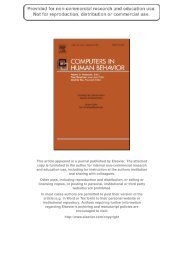Varnhagen.pdf
Create successful ePaper yourself
Turn your PDF publications into a flip-book with our unique Google optimized e-Paper software.
726 C. K. <strong>Varnhagen</strong> et al.<br />
misspelling. Neither of these categories is an example of new language so we<br />
classified these separately as Errors.<br />
Some words received more than one classification; for example, from Table 1,<br />
the insider word, hottie, was in all uppercase letters and so was scored both an<br />
insider word and as upper case. Other examples of multiple classifications include<br />
im, classified as lowercase and as a contraction error, and lol, classified both as a<br />
short cut acronym and as a pragmatic device emotion acronym. Approximately 3%<br />
of the words were scored as more than one category.<br />
The conversations were initially scored by a group of researchers (the authors and<br />
others) to define the categories of new language. The conversations were then<br />
rescored by researchers naive to the initial discussions, using the categories of<br />
definitions. A 20% sample was then scored a third time by a new naive rater.<br />
Agreement on overall identification of a word a new language was 99%. Cohen’s<br />
kappa (Cohen, 1960) for inter-rater agreement on scoring into the different<br />
categories was j = 0.97, indicating excellent inter-rater reliability and ease of<br />
classifying instances of new language according to our classification scheme.<br />
Results<br />
As this was an exploratory study and we conducted a large number of analyses, we<br />
a priori guarded against family-wise error by applying Bonferoni corrections<br />
(dividing alpha = 0.05 by the number of tests) to each set of statistical analyses<br />
conducted. Only results significant beyond the corrected alpha level are reported<br />
below.<br />
New language use<br />
Participants used an average of 31.8 instances of new language (SD = 14.1,<br />
range = 7–89) in their instant messages. Table 2 shows the mean frequencies in<br />
new language use for the different categories of new language. The means among<br />
the different categories add up to greater than the overall total because a few words<br />
could be classified into two categories (e.g., im is classified as both lower case and a<br />
contraction error; WUT is classified as both phonetic and upper case).<br />
Considering first the three groupings of categories, short cuts, pragmatic devices,<br />
and errors, we conducted a single factor repeated measures analysis of variance with<br />
the three general categories of short cuts, pragmatic devices, and errors as the repeated<br />
measures factor and participants as the random factor. We found a statistically<br />
significant difference among these three general categories, F(2, 78) = 53.07,<br />
p \ 0.001. Participants most often used short cuts in their instant messaging, followed<br />
by pragmatic devices to support their messages, followed by errors, Tukey’s post hoc<br />
HSD = 5.24, p \ 0.01.<br />
We also analyzed use of new language in each of the three general categories.<br />
We conducted a single factor repeated measures analysis of variance with the eight<br />
different shorts cuts categories as the repeated measures factor and participants as<br />
the random factor. We found a statistically significant difference among these three<br />
123
















